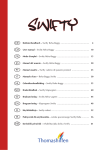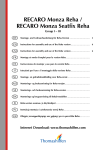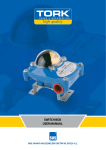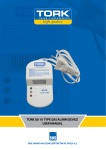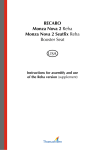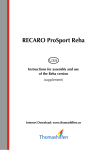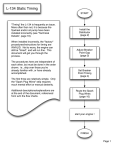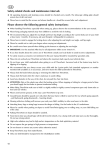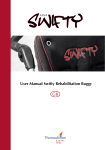Download User manual – Swifty Reha-Buggy
Transcript
User manual – Swifty Reha-Buggy ...............................................................10 (1) (2) (3) (4) (5) (6) (7) (8) (9) (10) (11) (12) 2 (13) (14) (15) Preferred Zone Optional Zone 30˚ 45˚ ˚ 75 (16) (17) 3 Dear Swifty user, the Swifty rehabilitation buggy is a modern, high-quality medical product with an attractive design. We have made a point of integrating the ideas of parents who are familiar with the day-to-day handling of rehabilitation products and know what their children need from these products. Rehabilitation care products don’t have to look “medical”, and the Swifty also fulfils all the requirements of a good rehabilitation buggy: Seat depth and lower leg length are continuously adjustable while the high-quality materials and solidly-built seat ensure comfort and safe handling. The buggy is highly-manoeuvrable thanks to its lightweight construction and front swivel wheels. It can be quickly and easily folded up and packed into the boot of any car. Should you have any questions or encounter any problems, please contact either us directly or your specialist dealer. Contents 10 page Safety-related checks and maintenance intervals................................................................................................................ 11 General safety information................................................................................................................................................. 11 Purpose and use................................................................................................................................................................. 11 Risks and contraindications................................................................................................................................................ 11 Technical specifications...................................................................................................................................................... 12 Unfolding / folding up........................................................................................................................................................ 12 Adjustment options............................................................................................................................................................. 12 Parking brake function........................................................................................................................................................ 12 H-belt................................................................................................................................................................................. 13 Mounting the belts............................................................................................................................................................. 13 Tip assist............................................................................................................................................................................. 13 Transport............................................................................................................................................................................ 13 Cleaning and care instructions............................................................................................................................................ 14 Guarantee conditions / CE- mark........................................................................................................................................ 14 Safety-related checks and maintenance intervals Should a problem be found when carrying out the regular checks, it should be immediately reported to the issuing authority, your local distrubutor or Thomashilfen. Routine maintenance The user’s family can easily carry out the following tasks. The supplied Allen key is required to tighten the footrest. 1. Always wipe the pushchair dry. Never put it away damp. 2. Check that the two footrest Allen screws are in place and are tight by using the Allen key (daily). 3. Check all nuts, bolts, and screws are tight (daily). 4. Check operation of the backrest, folding and reclining mechanisms (weekly). 5. Check operation of the brake always before using the pushchair. 6. Clean frame when necessary (we suggest at least once a week). Six-monthly maintenance Only someone who is a competent tradesman or repairer should carry out this work. If a major fault is found stop using the pushchair until it has been corrected. 1. Fold and open the pushchair. Check that all movements through the folding range are free. Examine frame for any damage. 2. Check operation of the pushchair and the seat back recline. 3. Examine nuts, screws, pivots and frame plugs for tightness and general condition. 4. Examine brake assembly for wear, damage and correct operation. 5. Examine tyres for sharp objects, cuts or splits. 6. Examine castor and wheel bearings for excessive wear. 7. Check castors and rear wheels for free rotation, security and accumulation of fluff and grit. Remove any fluff and grit with a dry lint free cloth. Please observe the following safety instructions: We recommend that you adjust the seat depth and lower leg length settings at least once every 3 months to suit your child’s growth. If necessary, seek assistance from your therapist / orthopaedic technician. Your child should always be secured using the H-belt (standard equipment, see page 13) or a suitable alternative belt (available as an accessory). CAUTION: Wet tyres can adversely affect braking. When not in use or stopping, secure the buggy using the foot brake to prevent it accidentally rolling away. Important: Do not leave the brake on when the pushchair is not in use for an extended period of time as this will damage the rear wheels. Please do not overload the Swifty rehabilitation buggy – refer to the specified maximum carrying capacity (see technical specifications). Take advantage of reflective clothing to make you and your child visible to other road users, particularly in the dark. Attaching shopping bags or other heavy items to the buggy increases the danger of it tipping over. We do not recommend that items are hung from the handle. Use the basket (available as an accessory) under the seat unit. When using the buggy, please follow the recommendations in the instruction manual, especially when folding and unfolding. Never leave your child unsupervised in the Swifty buggy. Always make sure the parking brake is engaged when transferring your child into or out of the buggy. To avoid the danger of choking, please keep plastic packing materials out of reach of your children. The buggy is suitable for carrying one child only. Purpose and use The Swifty Reha-Buggy is suited for the ergonomic transfer (push brace with adjustable height) of handicapped children, both outside and inside. Risks and contraindications Proper handling may avoid any use-related risks. No contraindications are known. 11 Technical specifications Swifty Reha-Buggy Seat depth Seat width Back height Lower leg length Hip angle Foot angle Seat tilt fix Footrest size (W x L) Overall dimensions (W x H x L) Dimensions when folded (W x H x L) Push bar height Wheel size, swivel wheels (front) Wheel size (rear) 22 - 28,5 cm / 8.7 - 11.2" 34 cm / 13.4" 62 cm / 24.4" 16 - 33 cm / 6.3 - 13" 90° to 115° 90° +15° 31 x 18 cm / 12.2 x 7.1" 61 x 102 x 98 cm / 24.0 x 40.2 x 38.6" 61 x 38 x 73 cm / 24.0 x 15.0 x 28.7" 80 - 119 cm / 31.5 - 46.9" 7,5" 10" Weight 12.4 kg / 27.3 lb Carrying capacity 35 kg / 77.2 lb Folding Unfolding Take hold of the buggy by the top side of the push bar and firmly pull it open (the sliders will lock audibly into place). Fold up the side plates of the seat to an upright position so that they lock securely into place. Tighten the lever on the back of the buggy. Set the height-adjustable push bar to the desired position using the buttons on the sides. (fig. 1) Folding up (minimum size) Release the quick-release mechanism on the back of the buggy. Pull up the sliders on the left and right bars and hold onto the safety bar mounted on the right. Use your upper body to push the push bar forwards and fold the buggy. (fig. 2) TIP: To avoid the front wheels coming into contact with the rear axle when folding the buggy, you can give the steering forks on the front wheels a slight turn. Adjustment options Seat depth Unscrew the front Allen screws (3 mm) on the seat surface, pull out the seat plate towards the front of the buggy and then re-tighten the Allen screws. (fig. 3) TIP: To make setting the seat depth easier, grasp the front edge of the seat surface with one hand while pressing your other hand against the bottom centre of the backrest. Adjusting the backrest Release the quick-release mechanism on the back of the buggy (using the lever), set the desired hip angle using the lever on the back bar, then retighten the lever. (fig. 4) Lower leg length Release the knurled screws at the back of the tube guides of the foot support. Bring the foot support into the desired position by pushing on the frame tube and fasten the screws again. (fig. 5). Footrest The footrest can be folded up for ease of transfer. (fig. 6) Parking brake function To engage: Press down the brake bar with your foot. To release: Place your foot beneath the brake bar and lift it up. 12 H-belt The Swifty rehabilitation buggy is supplied with H-belt as standard. Opening the belt fastener To open the H-belt, hold down the red button (1), open the clip connector (2 and 3) and release the belt (childproof safety catch). (fig. 7) Adjusting the shoulder belt height Open the velcro of the back upholstery. Open the two top cam buckles and pull out shoulder belt. Then cut the backrest upholstery in the quilted seam depending on the desired mounting height. Pass the belts through the slit created and insert the belts into the cam buckles. Close the two top cam buckles again and also close the velcro of the back upholstery. (fig. 8-10) Removing the H-belt Open the velcro of the back upholstery. Open the cam buckles and pull out H-belt. (fig. 9) Mounting the belts Cut the backrest upholstery in the quilted seam depending on the desired mounting height. Pass the two upper belts through the holes in the upholstery and insert them into the back plate. (fig. 8). Open the velcro of the back upholstery. Insert the belts into the cam buckles and adjust the desired belt length (fig. 9). The two bottom belt ends can be attached with cam buckles to the back plate (fig. 10). Guide the belts left and right next to the back upholstery to the corresponding cam buckle and fix them. Close the back upholstery. TIP: The belt length can also be adjusted from the front. Pull the D-ring to shorten the belt. Tip assist Put the foot on the tip assist, hold the Swifty rehabilitation buggy with both hands and crowd back. (fig. 11) Transporting The Swifty can be folded for transport in the luggage area of a vehicle. The Swifty has been successfully impact tested against international standard ISO 7176/19 and ANSI/RESNA WC/Vol.1 – Section 19 6/22/99 Draft and may be used as a vehicle seat. IMPORTANT: When used as a vehicle seat the following instructions must be followed. The Swifty rehabilitation buggy is designed to be forward-facing when used as a seat in a motor vehicle. The occupant should transfer to the vehicle seat and use the vehicle-installed restraint system whenever it is feasible. The 4 tie-down securement points are indicated with the following symbol: Preparing the Swifty for transport: 1. Remove the following (if fitted); pommel, play tray, rain hood, sun canopy, grip rail, accessory bag and shopping basket contents. 2. Position the pushchair correctly in the vehicle over the floor track with the front of the pushchair facing towards the front of the vehicle (in the direction of travel). Put the brakes on. 3. Make sure the hip angle adjustment is locked. Securing the Swifty in a Vehicle: 1. The pushchair must be secured in a vehicle using a 4-point tie down system that complies with either ISO 10542 Part 2, SAE 2249 or DIN 75078/2. (Such restraints are manufactured by Unwin Safety Systems and Q’Straint) 2. Vehicle operators and/or assistants should be fully trained in the use of wheelchair tiedown and occupant restraint systems. 3. The two front tie-downs must be attached left and right side to the steel ring located on each front castor mounting boss as shown in fig. 13. 4. The two rear tie-downs must be attached to the two securement points located on each side of the pushchair frame as shown in fig. 14. 13 Fitting the occupant restraint system: 1. The pushchair passenger must be restrained using an approved vehicle safety belt. Thomashilfen recommends the use of either a split reel double inertia seat belt or a 3-point occupant restraint system. (Such restraints are manufactured by Unwin Safety Systems and Q’Straint) 2. Vehicle operators and/or assistants should be fully trained in the use of wheelchair tie-downs and occupant restraint systems. 3. The occupant lap belt must be routed low over the pelvis, avoiding contact with the abdomen of the passenger. Lap belt routing should be inside of the occupant side pad on both left and right sides of the pushchair, as shown in fig. 15. 4. The lap belt should not be held away from body by rehabilitation buggy components or parts, such as side pads or wheels (fig. 16). NOTE: The belt webbing should not be twisted when in use. 5. The angle of the pelvic belt should be within the optimal zone of 30° to 75° to the horizontal, as shown in fig. 17. 6. The occupant lap belt should be tightened to make a snug fit without causing discomfort to the passenger. 7. If the pushchair is fitted with a harness, this should only be fastened after the occupant restraint system. 8. The shoulder belt of the occupant restraint system must be fitted to the side wall of the vehicle at a height that ensures the seat belt webbing lays in the middle of the occupants shoulder. NOTE: To meet current regulations only a shoulder belt fitted to the side wall of the vehicle should be used to correctly restrain the occupant. Cleaning and care instructions Upholstery The upholstery can be quickly and easily removed. The material and the spacer fabric are high quality materials that are washable up to 40°C. The upholstery is fire-retardant (BS 5852 part 1). Please remember that even high-quality materials are subject to fading through longterm exposure to intense sunlight or repeated washing. (fig. 12) Hook and loop fasteners To ensure that the hook and loop fasteners continue to function efficiently, clean them occasionally using a brush. Always try to keep the fasteners closed during washing. Chassis The chassis is manufactured from high-quality steel and aluminium tubing which is coated with a robust heat-enamel finish; and can be cleaned using commercially available no-toxic soap (neutral soap). Guarantee conditions / CE mark Thomashilfen offers you a guarantee of 3 years for all frame parts, commencing on the date of purchase. This guarantee incorporates all claims which influence functionality. Damages due to improper use (e.g. overloading), and natural wear and tear are excluded. Swifty meets the requirements of the European standards EN 12182 and 12183 and is provided with a CE marking. Enjoy using your Swifty rehabilitation buggy! 14








